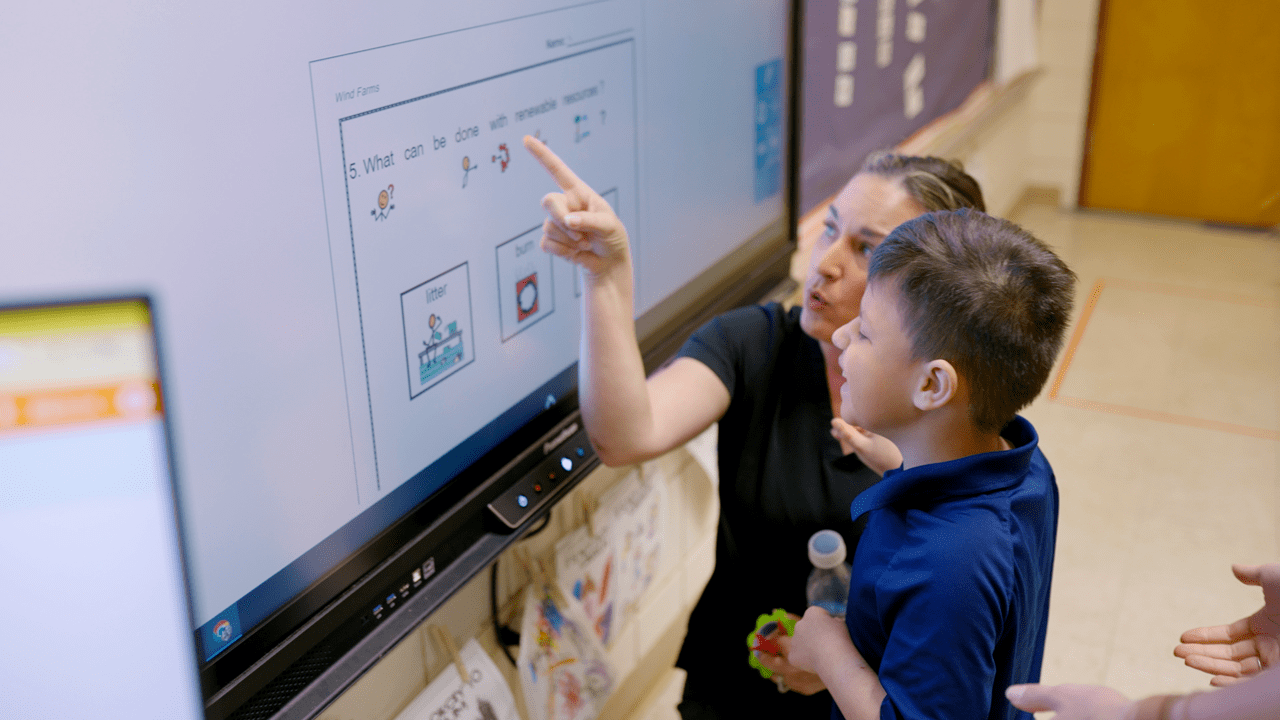The new school year is here—how are you feeling about it?
With schools reopening (or reopened) across the country, families are easing into what can only be described as “the new normal.” The pandemic is not in the rearview mirror, but the great majority of schools have opened their doors and are welcoming students back to in‑person learning. For many, the chance to learn face‑to‑face is a welcome relief.
The start of the school year invites families to adjust daily routines in the name of consistency and stability. Last year required all of us to embrace flexibility and changing schedules with a constant flood of new public health information. This year, with luck, will offer more balance for families. School can be one of the most comforting and safe places for a child, especially when the world around them feels confusing.
In this article, we offer strategies for establishing a family rhythm that supports a strong start to the new year as well as a handful of tips to stay on top of homework from early on.
Adjust Family Rhythms as School Starts
Parents: one of the most important ways you can help your child make a successful transition into the school year is to re‑establish a consistent routine a few weeks before school starts. Here are a few ways to do that:
Practice the School Year Schedule
Plan to impose a “school day” bedtime and wake‑up schedule a week or two before school starts. Many children go to bed later and wake up later during the summer. Waking up a couple of hours earlier than what has been typical for the past couple of months can be an unpleasant transition, so best to get an early start (pun intended) on readjusting your child’s body clock.
If the school year has already started, commit to consistent morning and evening routines—even for adolescents—during the first couple of months. Prioritizing the school schedule will help the whole family adjust to the new routines. This may mean you politely decline a weeknight dinner invitation or another special event to prioritize a full night’s sleep for your children. Not to worry! There will be more opportunities down the road.
Develop Regular Meal Times
Many families find new rhythms for meals during the summer. Breakfast might be later, snacks might be more frequent, and dinners may be on‑the‑go more often. In preparation for the school year, aim to implement a regular mealtime routine. Breakfast and lunch should occur at about the same time each day.
Use a Family Calendar
A family calendar can help everyone stay on track. A visually appealing and centrally located family calendar will show important due dates, family activities, and extracurricular activities.
SymbolStix PRIME is an excellent resource for families with individuals who use visual symbols to communicate. This comprehensive library of contemporary, multicultural, and dynamic symbols ensures everyone has access to language, learning, and self‑expression. You can use a couple of these symbols on your calendar to highlight an important upcoming activity.

When you create your calendar, try to keep it simple with just the most important information. This way, your attention will be directed to the key events of the week and month.
Set Your Child Up for Success with These 4 Homework Tips
Regardless of age and ability, most children have some kind of homework during the school week.
- For some, homework is a frustrating, exhausting process that takes unbearably long each night.
- For many, it’s a treasured time to show parents and older siblings what they learned during the school day.
- For most, homework falls somewhere in the middle—it’s part of the daily after‑school routine. Sometimes it’s fun, occasionally it’s hard and overwhelming.
What is homework usually like for you and your child?
You can support your child’s homework completion and increase the likelihood of peaceful afternoons and evenings with these 4 tips.
1. Review the Syllabi
Children often bring home a slew of papers at the beginning of the year for parents to sign, some of which are class syllabi. Take time to review the details of these important documents. Teachers usually explain their homework policy along with other important notes to promote success throughout the school year.
If the homework policy is not laid out in the syllabus, look for other introductory materials that provide an overview of what to expect. Perhaps your preschool- or kindergarten‑age daughter won’t have paper‑and‑pencil homework, but the teacher may ask you to read with her each night for 15 minutes. Common homework assignments for young children include reviewing sight words (you may receive a set of flashcards to review with your child), letter sounds, tracing letters and practicing name writing, and number identification and counting.
The beginning of the school year is a great time to ask your child’s teacher the big‑picture questions about homework:
- What is your philosophy on homework? (Practice? Remediation? Enrichment? School‑home connection?)
- How often should I expect my child to have homework? (Nightly? Three times per week? Rarely?)
- Approximately how long should most homework assignments take?
- Will homework be completed through an online learning portal, on paper, or both?
- Are there specific instructions for how homework must be completed? For example, must my son’s math homework be completed in pencil? Will he be required to show all steps of his math calculations?
- Are you aware of the homework accommodations my child has in his IEP?
Asking these questions at the beginning of the year will help you gain clarity on what is expected so you can support your child at home.
2. Create an Organization System
Now is the time to help your child create or tweak an organization system. The specific organizational tool you use isn’t as important as the fact that you use something and are consistent with its use.
For example, some teachers require an agenda, a system of color‑coded folders, or a 2‑inch binder with dividers. If your child’s teacher specifies a certain system—great! Help your child learn to use it.
Other teachers, especially those who teach older students, leave organizational tools up to the individual student.
Teachers often weave study habits and executive functioning skills throughout their curriculum, so try to reinforce what is being taught and encouraged at school. If you’re not sure what is being taught, check the syllabus or simply reach out to the teacher.
If you have a child with a learning or behavioral difference, such as attention‑deficit/ hyperactivity disorder (ADHD), he may find it challenging to stay organized with homework—especially at the end of a long school day! If this is the case, plan to invest more time at the beginning of the year to support your child in his new routines. He will likely benefit from modeling (showing him examples of what’s expected), repetition (doing the routine over and over), visual aids (a chart or poster with pictures and short reminders), and guidance (verbal cues and encouragement). With practice and consistency, though, a strong organization system will help him be successful with homework.
As a starting point, here are a few ideas for how to get and stay organized with homework:
- Create a system of color‑coded folders. Each subject gets a folder. Label one side as “To‑Do” and the other as “Complete.” (Alternatively, create a binder with dividers or another similar system that provides a space for work in each subject.)
- Devote a filing cabinet or desk drawer at home to school papers. Old IEPs, report cards, graded tests, completed homework assignments—everything should have a place unless it is ready to be recycled.
- Clean out the backpack at least once a week.
- Create an enlarged weekly homework calendar to post in a central location, such as near the kitchen table or along the entrance hallway.
- Make organization fun! Award your child a special certificate for displaying strong organizational skills, such as writing down the homework assignment or turning in the permission slip on time.
Asking these questions at the beginning of the year will help you gain clarity on what is expected so you can support your child at home.
3. Establish After‑School Routines
Some children come home from school and complete their homework right away. If this works for your family, great! Other children do best when they have a chance to play outside for a while, first. Also great!
Perhaps your son or daughter has after‑school activities, like sports practice or music lessons. Whatever the routine is for your family, try to stick with a consistent transition into homework.
You might try offering a small snack and a glass of water to kick off homework time, especially if it has been several hours since your child last ate. The brain boost will fuel her mental energy and help her to focus on her work.
Many children do best with a designated spot in the home to complete homework—a desk in the bedroom or a special table in a quiet living room with minimal distractions. Ideally, the homework spot will be stocked with all the supplies your child may need: access to a device (laptop, tablet), printer, charger, pens/pencils, highlighters, extra paper, calculator, headphones, etc. Ensuring the homework spot is well stocked will help minimize the number of times your child has to interrupt work time to ask for help.
Usually, a quiet space makes the most sense when trying to focus on schoolwork, but some children do work better when sprawled across the floor or at the kitchen table with background music and household noise. Figure out what works for your child.
4. Offer Motivation and Praise
Genuine and specific praise is an excellent way to shape behavior. Be sure to offer plenty of it for your child who is still learning study skills and strategies to tackle homework accurately and on time. You may need to dig deep to find the patience to sit with your child as he works through assignments, but doing so will model the steadfast commitment to his work. What a wonderful way to connect with your child!
Rather than general platitudes like “Good job,” comment on the specific actions you see your son or daughter taking to complete homework. Here are a few examples:
I saw you used your new note‑taking method. Great work implementing this strategy from class!
I am proud of you for double‑checking your math homework before putting it back into your folder.
Way to go for advocating for yourself to get a short break in between subjects!
I noticed you sat in your special reading chair for the whole 10 minutes of silent reading time. I love how dedicated you are!



